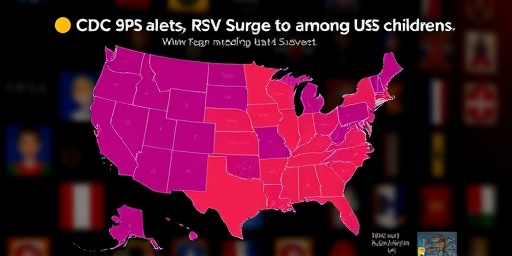Washington, DC – The Centers for Disease Control and Prevention (CDC) has issued an urgent warning as respiratory syncytial virus (RSV) cases explode among infants and toddlers nationwide, leading to a sharp surge in hospitalizations. In the past two weeks alone, RSV-related hospital admissions for children under 2 years old have risen by over 60% in 14 states, overwhelming pediatric wards just as flu season ramps up.
According to the CDC’s latest data from its Respiratory Virus Net surveillance network, weekly RSV detections in emergency departments jumped from 2.5% to 4.1% among young children, with hospitalizations hitting 3.7 per 100,000 children in the most affected regions. This marks the earliest and most intense RSV season in years, prompting health officials to recommend immediate precautions like masking in crowded indoor spaces and rigorous hand hygiene.
RSV Hospitalizations Double in Southern and Midwestern States
The surge in RSV is hitting hardest in the South and Midwest, where warmer weather has delayed the typical winter peak. Texas reported a staggering 150% increase in pediatric RSV hospitalizations over the last month, with Dallas-area hospitals diverting patients due to capacity strains. Similarly, Georgia and Tennessee saw rates climb to 5.2 and 4.8 per 100,000 children, respectively, per CDC figures released Friday.
In the Midwest, Ohio and Illinois are grappling with emergency room bottlenecks. Cincinnati Children’s Hospital, one of the nation’s busiest pediatric centers, treated 250 RSV cases in a single week – double last year’s numbers at this time. “We’re seeing kids who were healthy just days ago now on oxygen support,” said Dr. Samir Shah, the hospital’s president and CEO, in a statement to local media.
- Texas: RSV positivity rate at 12% in pediatric ERs, up from 4% last season.
- Georgia: 78 hospitalizations per week among infants.
- Illinois: 40% of pediatric ICU beds occupied by RSV patients.
The CDC attributes this regional spike to post-pandemic immunity gaps, where reduced exposure during COVID lockdowns left many children‘s immune systems vulnerable. Wastewater surveillance data corroborates the trend, showing RSV viral loads 3-5 times higher than 2022 baselines in affected cities.
CDC’s Targeted Precautions Amid Intensifying Flu Overlap
In response to the RSV surge, the CDC has rolled out specific, actionable advice for parents, daycare providers, and schools. “RSV spreads like wildfire in group settings, especially with flu circulating simultaneously,” said CDC Director Dr. Mandy Cohen in a virtual press briefing. Key recommendations include:
- Masking: Wear well-fitting masks indoors when around infants or in healthcare settings.
- Hand Hygiene: Wash hands for 20 seconds or use sanitizer with at least 60% alcohol before touching babies.
- Avoid Crowds: Limit exposure in high-risk environments like malls or public transit during peak hours.
- Sick Child Policies: Keep symptomatic children home until fever-free for 24 hours without medication.
The agency also emphasizes high-risk groups: premature infants, those with heart or lung conditions, and children under 6 months. For them, new monoclonal antibody treatments like nirsevimab offer up to 80% protection, though supply shortages have limited access in rural areas.
Flu-RSV Double Threat: Why Hospitals Are Overloaded
This year’s respiratory illness season is uniquely brutal due to the RSV-flu convergence. CDC data shows influenza positivity at 15% nationally, with 28 pediatric deaths reported so far – many co-infected with RSV. In California, where RSV hospitalizations among children rose 75%, officials declared a “tripledemic” alert, urging COVID vaccinations alongside RSV precautions.
“The overlap is crushing our system,” noted Dr. Sean O’Leary, a pediatric infectious disease specialist at Children’s Hospital Colorado. “We’ve had to postpone elective surgeries to free up beds for these tiny patients fighting for breath.”
Pediatricians Warn of Immunity Debt Fueling the Crisis
Experts point to “immunity debt” as a primary driver of the RSV surge. During the pandemic, masking and distancing slashed RSV circulation by 70-90%, per a 2023 New England Journal of Medicine study. Now, naive immune systems in young children are encountering the virus en masse.
“This isn’t just a bad year; it’s a reckoning for lost herd immunity,” said Dr. Yvonne Maldonado, chief of pediatric infectious diseases at Stanford Medicine. “Hospitalizations are mirroring 2014-2015 levels, the worst on record.”
RSV, a common virus causing cold-like symptoms in adults, turns severe in infants, leading to bronchiolitis – inflammation of the tiny airways. Symptoms include wheezing, rapid breathing, and blue lips, necessitating oxygen or ventilation in 2-3% of cases. Last season, RSV contributed to 58,000-80,000 hospitalizations and 100-300 deaths in US children under 5, per CDC estimates.
Demographic Breakdown: Infants Under 6 Months Hit Hardest
Data reveals stark disparities:
| Age Group | Hospitalization Rate (per 100k) | Increase from 2023 |
|---|---|---|
| <6 months | 12.4 | +85% |
| 6-24 months | 4.2 | +62% |
| 2-4 years | 1.1 | +45% |
Hispanic and Black children face 1.5-2 times higher rates, linked to socioeconomic factors like crowded housing and limited healthcare access.
Real Families Share Heartbreaking RSV Battles
Beyond the numbers, the human toll is evident in stories from affected families. In Atlanta, single mom Maria Gonzalez rushed her 4-month-old son, Mateo, to the ER after he struggled to breathe overnight. “He went from playful to gasping in hours,” she recounted. Mateo spent five days on high-flow oxygen, one of 120 RSV patients that week at Children’s Healthcare of Atlanta.
In Nashville, the RSV surge claimed its first infant life this season – 3-month-old Elijah Brooks, who had underlying congenital heart disease. “We did everything right – handwashing, no visitors – but it wasn’t enough,” said his father, tearfully speaking to reporters.
Social media is flooded with parent pleas: #RSVSurge has trended with 50,000 posts, sharing tips and pleas for monoclonal antibody availability. Pediatric groups like the American Academy of Pediatrics (AAP) are advocating for expanded insurance coverage of preventive shots.
Vaccines and Monitoring: Hope on the Horizon for RSV Control
As the CDC ramps up surveillance through its VISION network, tracking 70 hospitals nationwide, promising developments loom. FDA-approved RSV vaccines for pregnant women (Abrysvo) and older adults (Arexvy) indirectly protect infants via maternal antibodies, reducing severe cases by 82% in trials.
For direct infant protection, nirsevimab’s emergency stockpiles are being distributed, with enough doses projected for 50% coverage by December. GSK’s Arexvy and Pfizer’s Abrysvo are expanding trials for toddlers.
Looking ahead, the CDC plans weekly updates and potential school closure guidelines if hospitalizations exceed 10 per 100,000. State health departments are activating surge plans, including telehealth for mild cases to ease ER burdens.
Public health advocates urge vaccination drives and community education. “We can blunt this wave with vigilance,” Dr. Cohen affirmed. “Parents, act now – RSV doesn’t wait.” As winter deepens, the nation braces for peak season, hoping precautions stem the tide before more children suffer.









